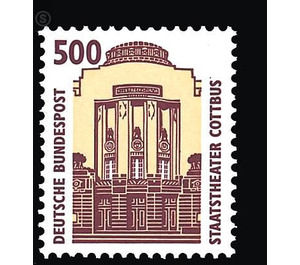Postage stamps: sights - Germany / Federal Republic of Germany 1993 - 500 Pfennig
Theme: Architecture
| Country | Germany / Federal Republic of Germany |
| Issue Date | 1993 |
| Face Value | 500.00 |
| Color | brown white |
| Perforation | K 14 |
| Printing Type | indirect 2-color letterpress |
| Stamp Type | Postage stamp |
| Item Type | Stamp |
| Chronological Issue Number | 1552 |
| Chronological Chapter | GER-BRD |
| Michel ID | BRD 1679 |
| SID | 412463 |
| In 45 Wishlists | |
On November 1, 1905, the city council in Cottbus decided to build a city theater. Thus, the wishes of the Cottbus bourgeoisie were taken into account, which wanted to see its increasingly strong economic and political position also culturally represented. The winner of the architectural competition was Bernhard Sehring, who had already caused a sensation in Berlin with his first theater production »Theater des Westens« in 1896 and had influenced the architectural design of other theaters and buildings with his work, which was committed to Art Nouveau. The location chosen was the cattle market, today's Schillerplatz. On June 1, 1907, the excavation work began, and on October 1, 1908, the theater was opened with Lessing's comedy "Minna von Barnhelm" solemnly. The Theater in Cottbus is the clearest and most mature architectural achievement of Bernhard Sehring - a building of the secessionist late youth style. Sehring has succeeded in achieving a functionally clear synthesis of architecture, handicrafts, painting and sculpture. The massive ground floor, topped with sandstone blocks, is continued above in Terranova plastering technique, which is interrupted by lead-glazed windows. Simple plaster strips break the upper part of the building, and sparingly used sculptures made of sandstone or concrete complete the whole to a pleasant appearance. Plywood, putti, and ram heads in stamped concrete show how the architect has managed to work cost-effectively with prefabricated materials. In the Düsseldorf Schauspielhaus many elements of the Cottbus theater were already outlined, so the floor plan of the auditorium, the generous foyers, the coffered dome space in 1st place and the main lodge flanked by Kariatyden, visually added to the oval by mirror, or the Rangbrüstungen and for Sehring so typical simple naked bulb, with which he created a veritable lighting architecture and in the auditorium associated a starry sky. The elegant color scheme gives the interior an unmistakable character: the foyer in the parquet is covered in a blue-green color, first-class plaster brushing over a marble base already used in the entrance hall and the stairwells, and yellow-green in the auditorium. rosewood pastel shades with white tips. Bronzierte elements and brass parts such as lamps and door fittings set the highlights. The entire ceiling ceiling is colored. Genuine marble cladding is related below the proscenium box; Stucco marble columns carry their canopies, which are crowned by panther harnesses. In 1910, the theater was supplemented by a functional new building on the back, which was connected by a two-storey hinge. He is a simple, objective building with few decorative elements. From 1981 to 1986 the house was subjected to a comprehensive reconstruction and repair. The aim was to stop the further deterioration of the building fabric, to preserve the monument of the late youth style and to return it to its original use, to improve the working and living conditions for the ensembles and to renew the theater technique. The preservation of monuments required preserving originals, restoring original forms and qualities and, in the case of necessary redesigns, using elements of the Art Nouveau style and classifying them architecturally. For some of the projects, optimal solutions were sought and found - to the benefit of the theater people and to the delight of the audience. (Text: Jutta Maria Winkler, chief dramaturge of the Staatstheater Cottbus, using a work by senior conservator, graduate engineer Harry Linge)
| Condition | Name | In Stock | Price | Price + Shipping | Store | |
|---|---|---|---|---|---|---|
 | Unmounted Mint ** | Postage stamps: sights - Germany / Federal Republic of Germany 1993 - 500 Pfennig | 1 | US $3.75 | US $6.95 |  FILATELIELOKET (0) FILATELIELOKET (0)Shipping US $3.20 |


